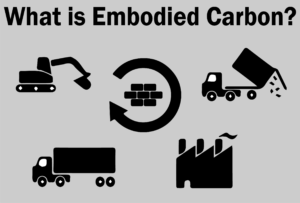Building materials are one of the most significant contributors to carbon emission. The construction industry has been working to find the quickest and most accurate way to measure the impact of these products on the environment. The new Embodied Carbon in Construction Calculator (EC3) tool helps in calculating carbon emissions within building materials which were developed and funded by incorporation with Skanska and the software developer C Change Labs, who are determined to maximize the impact of the tool for reducing global carbon emission.
What do we understand by Embodied Carbon?
Embodied carbon refers to the carbon footprint of materials. It considers all the greenhouse emission that is released throughout the supply chain and is measured through the extraction of materials to its end of life process. Operation carbon refers to the emission of gases during the use of buildings. The whole carbon emissions (embodied + operational) counts for 20% to 50% of total global emissions, which is a very significant proportion and will only help in improving the standards of building construction.

The very first step is to identify the hot spots for carbon emissions, materials, and systems that contribute the most to a building’s embodied greenhouse emissions. This way, choosing the best sustainable material could be the priority of any design process. Calculation of carbon footprint in building and construction requires a huge analysis of materials, products and assembling systems. Architects are moving towards alternative building material for construction.
What is EC3?
The tool creates the first digitized EPDs for building materials through designed platforms that help to accelerate the adoption process for better sustainable materials. It’s a free, open-access database of digitized Environmental Product Declaration (EPDs). The tool is the industry’s first database that will allow architects, engineers, building material supplies and users to easily evaluate the carbon emission from construction materials. EC3 is an effectively empowering tool that reduces embodied carbon within buildings at true scale.
The building and construction sector are responsible for 40% of the total global greenhouse gas (GHG) emissions. Embodied carbon emission comes from manufacturing, transportation, installation and lifetime use of the material, the tool is designed to consider all these emissions. Some of these emissions can be reduced by buildings over time or by reducing impact through energy-efficient renovations.

How EC3 tools help in improving building construction?
The alliance claims that during the trial period, participating projects managed to reduce building’s embodied carbon emission by 30 percent without any significant financial changes. EC3 is now publically available and freely accessible through registration at building transparency website. The collection of data is private and completely confidential. The tool is guided through a primer which helps though every stage of building construction.
The database includes more than 16,000 materials including concrete, metals, wood, glass, carpet, tiles and many more different kinds of material. “It may not matter how efficiently we operate our buildings over time if we don’t immediately address the carbon embodied in what and how we build,” said Skanska USA Chief Sustainability Officer, Beth Heider, FAIA. “We have only a short time to actionably reduce carbon emissions as a society. With our benchmarking and the EC3 tool, we more fully understand the emissions footprint of how and what we build, and can chart an urgent course toward its reduction.”



